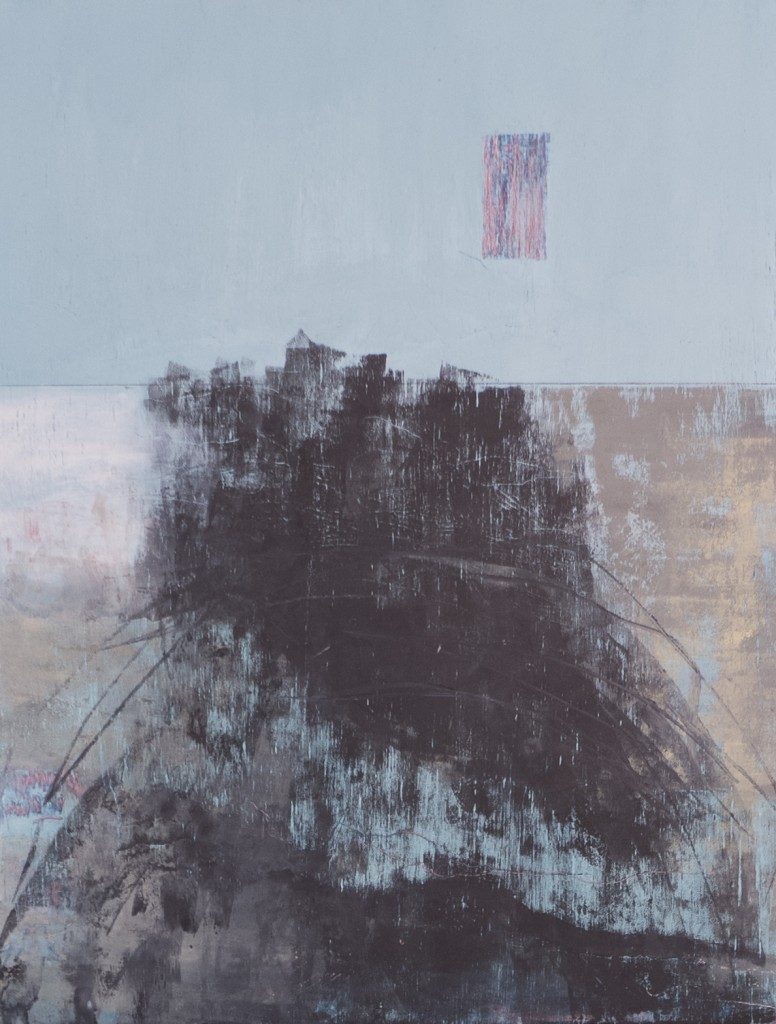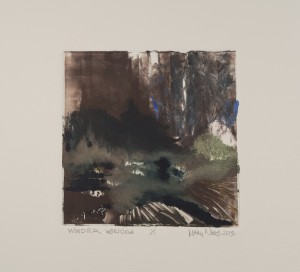To have a sense of character, one has to spend some time observing and experiencing. We make decisions on character based on what we see, sometimes quickly, sometimes considerably. When someone then does something “out of character,” we state our surprise according to a prior set of expectations, coming out of some kind of history. Shift to the realm of ideas. When it comes to knowing or recognizing what is good and what is truly evil, it seems to me that we have lost our way. We have given up caring to know. Discernment is hard to find in a culture which denigrates any reflective judgement.
I decided to name these two pieces (last post and this image). “The Nature of Evil” and “The Nature of Good” because of their complete contrast in visual character. These two serve as a primer, using symbolic imagery to introduce the notion that there are two material poles: one is good, the other is fearfully evil. And if this reality is even remotely true, being alert to the character of these poles would be a significant pursuit.
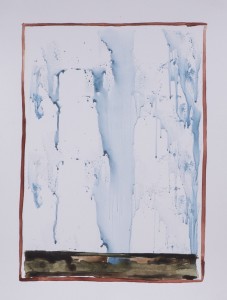 The first image, that of evil, called Abaddon, is dominant and encroaching, seemingly boundless and fearful. The second image is much quieter, gentle but life-giving, boundaried but free. It penetrates the ground rather than taking it over. And it is rimmed by this mysteriously fragile red enclosure. When I made this second image it was after studying some illuminated manuscripts from a book a friend had given me. The first image, as I wrote earlier, took over when I made it, surprised me, troubled me. But it seemed necessary to consider. This second image was planned more carefully, but its making also involved some serendipity. I used a brayer to lay down the veils of blue watercolor, loving the delicate surprise in the markings that resulted, and that were still “in character” with the quiet beauty of good.
The first image, that of evil, called Abaddon, is dominant and encroaching, seemingly boundless and fearful. The second image is much quieter, gentle but life-giving, boundaried but free. It penetrates the ground rather than taking it over. And it is rimmed by this mysteriously fragile red enclosure. When I made this second image it was after studying some illuminated manuscripts from a book a friend had given me. The first image, as I wrote earlier, took over when I made it, surprised me, troubled me. But it seemed necessary to consider. This second image was planned more carefully, but its making also involved some serendipity. I used a brayer to lay down the veils of blue watercolor, loving the delicate surprise in the markings that resulted, and that were still “in character” with the quiet beauty of good.
This from Art & Fear, p.103 “What Science bears witness to experimentally, art has always known intuitively–that there is an innate rightness to the recurring forms of nature.” If you are able, please come see these pieces along with work from several other fine artisans at the Reece Museum on campus of East TN State, until September 12th, 2014.
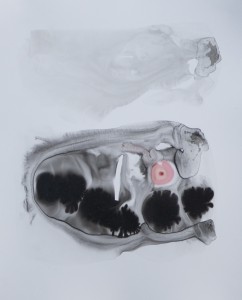 This image, which is the last in a 4 part series (still hanging at the Reece Museum on ETSU’s campus) is a visual glimpse. There are two parts to it’s form: a wispy cloud-like from in the upper horizon, and a more grounded darker mass. Both these forms show movement in one direction, and they are moving together that way. The bottom form is enclosed, and seems to be a holding place that is dynamic and not completely shut. This is a picture of fearful grace. Fear must come first for grace to even be a topic of concern. Both these ideas are glimpsed here. I could say more. I would be interested in how this image affects viewers who may well see more, or who may see what I did not intend as this gets viewed and judged and passed over as part of the public record. For me, as I made this, and as I still muse on what dried in front of me with the inks settling: this is a glimpse of hope that still hangs in time.
This image, which is the last in a 4 part series (still hanging at the Reece Museum on ETSU’s campus) is a visual glimpse. There are two parts to it’s form: a wispy cloud-like from in the upper horizon, and a more grounded darker mass. Both these forms show movement in one direction, and they are moving together that way. The bottom form is enclosed, and seems to be a holding place that is dynamic and not completely shut. This is a picture of fearful grace. Fear must come first for grace to even be a topic of concern. Both these ideas are glimpsed here. I could say more. I would be interested in how this image affects viewers who may well see more, or who may see what I did not intend as this gets viewed and judged and passed over as part of the public record. For me, as I made this, and as I still muse on what dried in front of me with the inks settling: this is a glimpse of hope that still hangs in time.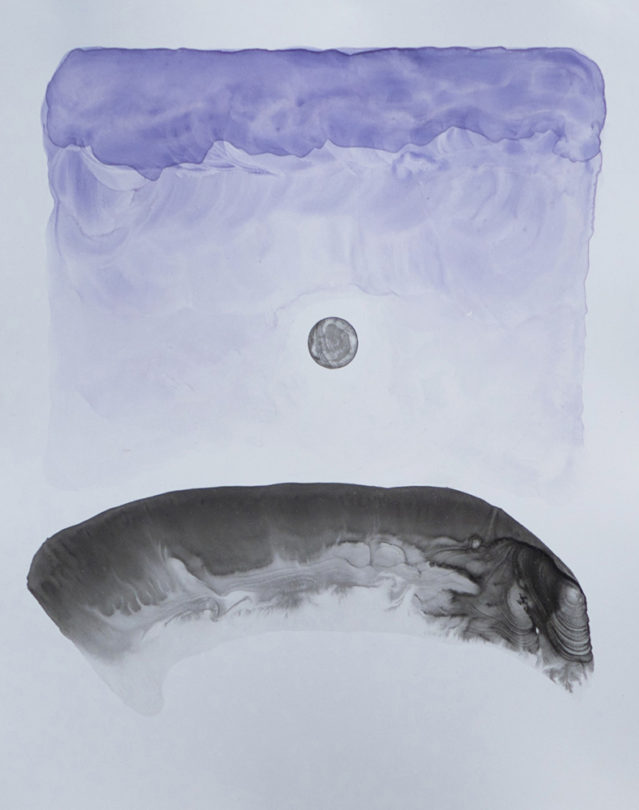
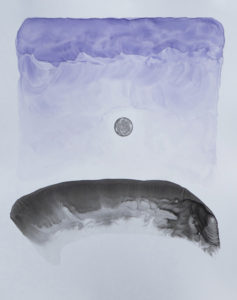
 The first image, that of evil, called Abaddon, is dominant and encroaching, seemingly boundless and fearful. The second image is much quieter, gentle but life-giving, boundaried but free. It penetrates the ground rather than taking it over. And it is rimmed by this mysteriously fragile red enclosure. When I made this second image it was after studying some illuminated manuscripts from a book a friend had given me. The first image, as I wrote earlier, took over when I made it, surprised me, troubled me. But it seemed necessary to consider. This second image was planned more carefully, but its making also involved some serendipity. I used a brayer to lay down the veils of blue watercolor, loving the delicate surprise in the markings that resulted, and that were still “in character” with the quiet beauty of good.
The first image, that of evil, called Abaddon, is dominant and encroaching, seemingly boundless and fearful. The second image is much quieter, gentle but life-giving, boundaried but free. It penetrates the ground rather than taking it over. And it is rimmed by this mysteriously fragile red enclosure. When I made this second image it was after studying some illuminated manuscripts from a book a friend had given me. The first image, as I wrote earlier, took over when I made it, surprised me, troubled me. But it seemed necessary to consider. This second image was planned more carefully, but its making also involved some serendipity. I used a brayer to lay down the veils of blue watercolor, loving the delicate surprise in the markings that resulted, and that were still “in character” with the quiet beauty of good.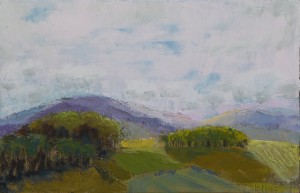 This is where I get to live! My husband and I still revel in such a place to be. He loves the quiet the most. I love the long views. I grew up in flat lands. I was always looking out the windows though, searching, even as a child for something (I knew not what to even call it). I just remember the ache and the longing. And I especially was enchanted by the lines that seemed to point to horizons. Now my horizons are much more enchanting, irregular, changing, suggesting deeper promise.
This is where I get to live! My husband and I still revel in such a place to be. He loves the quiet the most. I love the long views. I grew up in flat lands. I was always looking out the windows though, searching, even as a child for something (I knew not what to even call it). I just remember the ache and the longing. And I especially was enchanted by the lines that seemed to point to horizons. Now my horizons are much more enchanting, irregular, changing, suggesting deeper promise.